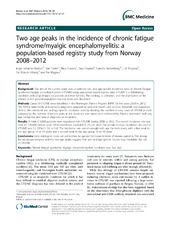| dc.contributor.author | Bakken, Inger Johanne | en_US |
| dc.contributor.author | Tveito, Kari | en_US |
| dc.contributor.author | Gunnes, Nina | en_US |
| dc.contributor.author | Ghaderi, Sara | en_US |
| dc.contributor.author | Stoltenberg, Camilla | en_US |
| dc.contributor.author | Trogstad, Lill | en_US |
| dc.contributor.author | Håberg, Siri Eldevik | en_US |
| dc.contributor.author | Magnus, Per | en_US |
| dc.date.accessioned | 2014-10-07T12:57:57Z | |
| dc.date.available | 2014-10-07T12:57:57Z | |
| dc.date.issued | 2014-10-01 | eng |
| dc.identifier.issn | 1741-7015 | |
| dc.identifier.uri | https://hdl.handle.net/1956/8600 | |
| dc.description.abstract | Background: The aim of the current study was to estimate sex- and age-specific incidence rates of chronic fatigue syndrome/myalgic encephalomyelitis (CFS/ME) using population-based registry data. CFS/ME is a debilitating condition with large impact on patients and their families. The etiology is unknown, and the distribution of the disease in the general population has not been well described. Methods: Cases of CFS/ME were identified in the Norwegian Patient Register (NPR) for the years 2008 to 2012. The NPR is nationwide and contains diagnoses assigned by specialist health care services (hospitals and outpatient clinics). We estimated sex- and age-specific incidence rates by dividing the number of new cases of CFS/ME in each category by the number of person years at risk. Incidence rate ratios were estimated by Poisson regression with sex, age categories, and year of diagnosis as covariates. Results: A total of 5,809 patients were registered with CFS/ME during 2008 to 2012. The overall incidence rate was 25.8 per 100,000 person years (95% confidence interval (CI): 25.2 to 26.5). The female to male incidence rate ratio of CFS/ME was 3.2 (95% CI: 3.0 to 3.4). The incidence rate varied strongly with age for both sexes, with a first peak in the age group 10 to 19 years and a second peak in the age group 30 to 39 years. Conclusions: Early etiological clues can sometimes be gained from examination of disease patterns. The strong female preponderance and the two age peaks suggest that sex- and age-specific factors may modulate the risk of CFS/ME. | en_US |
| dc.language.iso | eng | eng |
| dc.publisher | BioMed Central | eng |
| dc.rights | Attribution CC BY | eng |
| dc.rights.uri | http://creativecommons.org/licenses/by/4.0 | eng |
| dc.subject | Chronic fatigue syndrome | eng |
| dc.subject | Myalgic encephalomyelitis | eng |
| dc.subject | Incidence rate | eng |
| dc.subject | Sex | eng |
| dc.subject | Age | eng |
| dc.title | Two age peaks in the incidence of chronic fatigue syndrome/myalgic encephalomyelitis: a population-based registry study from Norway 2008-2012 | en_US |
| dc.type | Peer reviewed | |
| dc.type | Journal article | |
| dc.date.updated | 2014-10-03T19:07:00Z | |
| dc.description.version | publishedVersion | en_US |
| dc.rights.holder | Copyright 2014 Bakken et al.; licensee BioMed Central Ltd. | |
| dc.rights.holder | Inger Johanne Bakken et al.; licensee BioMed Central Ltd. | |
| dc.source.articlenumber | 167 | |
| dc.identifier.doi | https://doi.org/10.1186/s12916-014-0167-5 | |
| dc.identifier.cristin | 1199264 | |
| dc.source.journal | BMC Medicine | |
| dc.source.40 | 12 | |

